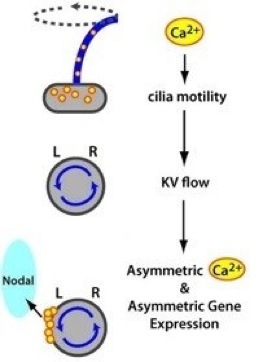REsearch


















The internal organs are asymmetrically placed along the left-right axis. While asymmetric gene expression in the lateral mesoderm is regulated by an evolutionarily conserved signaling pathway, mechanisms by which the initial left-right symmetry is broken appear to be divergent.
In zebrafish, cilia driven fluid flow in the Kupffer’s vesicle (KV) is required for the establishment of the left-right axis, and calcium signaling is thought to regulate KV cilia formation and transduce KV fluid flow-generated asymmetric signals to initiate asymmetric gene expression in the lateral mesoderm. Our previous work showed that blocking the activities of Na,K-ATPase alpha2 and NCX4a in KV results in an increase of intracellular calcium levels, a loss of KV ciliary motility, and a randomization of internal organ positions. Blocking CaMKII in Na,K-ATPase alpha2 and NCX4a deficient embryos restores KV ciliary motility, KV fluid flow and normal placement of internal organs, indicating that KV ciliary motility is modulated by the intracellular calcium levels.
In addition, we have noted significant contributions of the dynein regulatory complex and the fused protein in ciliogenesis. Currently, we focus on understanding the mechanism by which cilary motility is regulated.
Left-Right Asymmetry and Ciliogenesis









